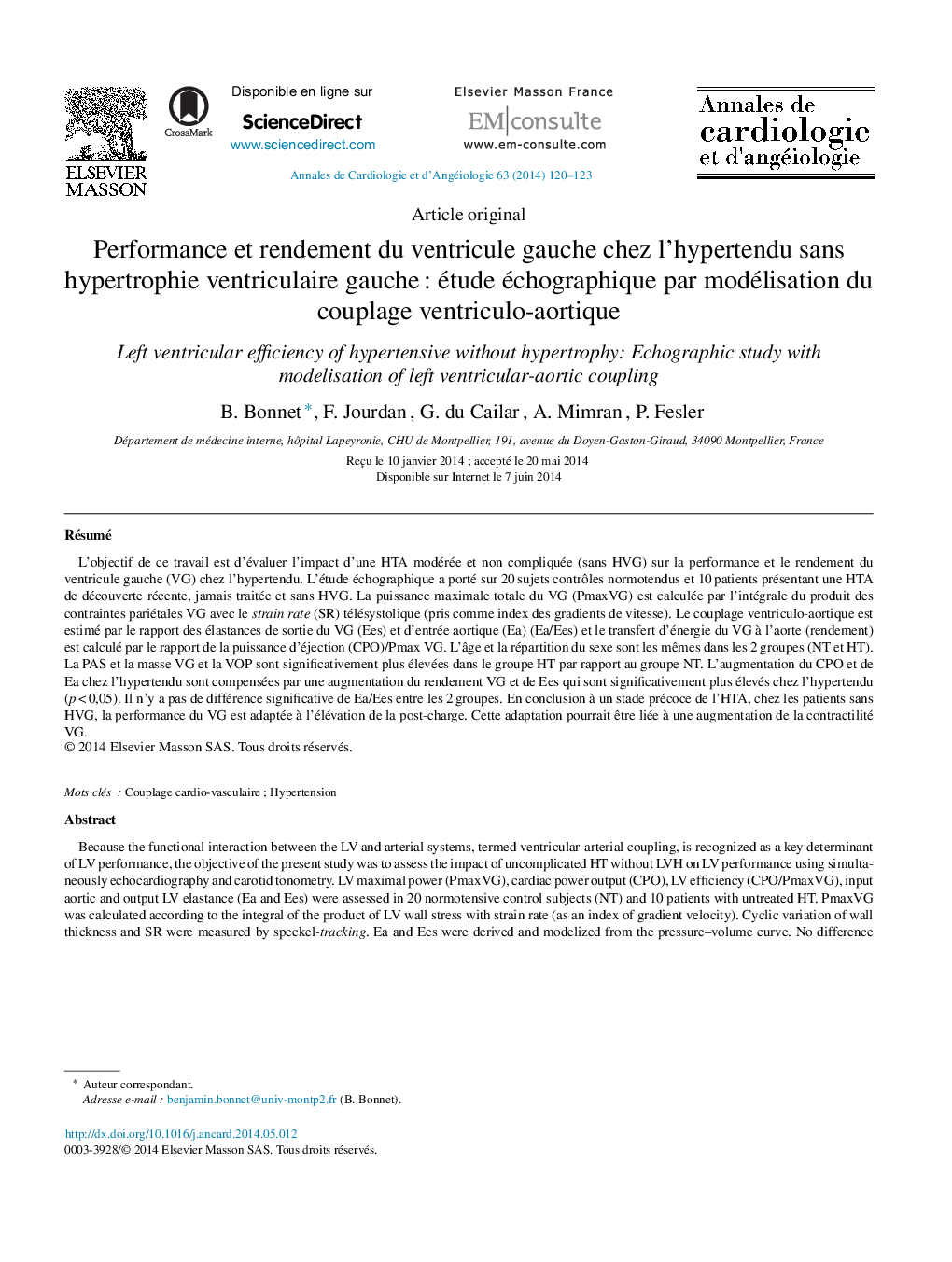| Article ID | Journal | Published Year | Pages | File Type |
|---|---|---|---|---|
| 2868807 | Annales de Cardiologie et d'Angéiologie | 2014 | 4 Pages |
RésuméL’objectif de ce travail est d’évaluer l’impact d’une HTA modérée et non compliquée (sans HVG) sur la performance et le rendement du ventricule gauche (VG) chez l’hypertendu. L’étude échographique a porté sur 20 sujets contrôles normotendus et 10 patients présentant une HTA de découverte récente, jamais traitée et sans HVG. La puissance maximale totale du VG (PmaxVG) est calculée par l’intégrale du produit des contraintes pariétales VG avec le strain rate (SR) télésystolique (pris comme index des gradients de vitesse). Le couplage ventriculo-aortique est estimé par le rapport des élastances de sortie du VG (Ees) et d’entrée aortique (Ea) (Ea/Ees) et le transfert d’énergie du VG à l’aorte (rendement) est calculé par le rapport de la puissance d’éjection (CPO)/Pmax VG. L’âge et la répartition du sexe sont les mêmes dans les 2 groupes (NT et HT). La PAS et la masse VG et la VOP sont significativement plus élevées dans le groupe HT par rapport au groupe NT. L’augmentation du CPO et de Ea chez l’hypertendu sont compensées par une augmentation du rendement VG et de Ees qui sont significativement plus élevés chez l’hypertendu (p < 0,05). Il n’y a pas de différence significative de Ea/Ees entre les 2 groupes. En conclusion à un stade précoce de l’HTA, chez les patients sans HVG, la performance du VG est adaptée à l’élévation de la post-charge. Cette adaptation pourrait être liée à une augmentation de la contractilité VG.
Because the functional interaction between the LV and arterial systems, termed ventricular-arterial coupling, is recognized as a key determinant of LV performance, the objective of the present study was to assess the impact of uncomplicated HT without LVH on LV performance using simultaneously echocardiography and carotid tonometry. LV maximal power (PmaxVG), cardiac power output (CPO), LV efficiency (CPO/PmaxVG), input aortic and output LV elastance (Ea and Ees) were assessed in 20 normotensive control subjects (NT) and 10 patients with untreated HT. PmaxVG was calculated according to the integral of the product of LV wall stress with strain rate (as an index of gradient velocity). Cyclic variation of wall thickness and SR were measured by speckel-tracking. Ea and Ees were derived and modelized from the pressure–volume curve. No difference in age, BMI and sex ratio was observed between NT and HT. Systolic BP (160 ± 18 vs. 119 ± 10 mmHg), LV mass (99 ± 15 vs. 76 ± 12 g/m2), PWV (9.7 ± 2 vs. 6.9 ± 1 m/s) were significantly higher (P < 0.01) in HT when compared to NT. In HT increased of CPO and Ea was compensated by an increase of LV (15 ± 4 vs. 12 ± 3%, P < 0.02) and Ees (5.5 ± 2 vs. 4.5 ± 1.5 mmHg/mL), which are significantly elevated in HT (P < 0.05). No difference was observed in Ea/Ees between NT and HT. In conclusion at the early phase of HT, in patients without LVH, LV performance and ventricular-arterial coupling were adapted to post-load elevation. This adaptation may be the result of an increased of LV contractility.
